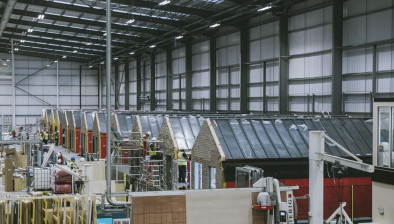Younger buyers sacrifice safety to get a foot on the housing ladder
Younger people are more willing to buy a home prone to safety, flood or crime risks in order to get on the housing ladder, new research from insurance giant Aviva reveals.
According to the findings, a third of would-be homebuyers aged 34 and under say they would buy a home in a high crime area (34 per cent for both 18-24s and 25-34s). Across all age groups, only 19 per cent would do the same, falling to just 7 per cent of those aged 55 and above.
Despite widespread coverage of damage caused by flooding in recent years, almost half of 18-24s (44 per cent) and 36 per cent of 25-34s would consider living in a flood-risk area, compared to 23 per cent across all age groups, and only 8 per cent of those aged 55 and above. The nation’s love of ‘doing up’ homes is also highlighted, with more than six in 10 people across all age groups saying they would buy a property needing significant improvements in order to provide safe accommodation:
Anxiety over being able to afford a property could be leading younger buyers to make sacrifices when it comes to the safety and location of their home. Previous research from Aviva highlights the continued importance of homeownership in the UK, with four fifths (79 per cent) of people agreeing becoming a homeowner was important to them. However, a quarter (27 per cent) fear they will never be able to afford to buy a property.
In addition, Aviva research reveals two thirds (67 per cent) of UK adults would relocate solely to be able to afford cheaper housing, rising to 83 per cent of 18-24s. Among those who have already purchased a home, 20 per cent relocated to an area that was cheaper: again, this was more likely among younger age groups (40 per cent of 16-24s and 33 per cent of 25-34s). Of these, nearly two in five moved to somewhere they didn’t particularly want to live and only did so for affordability reasons.
When asked about the five most important factors when buying a home, the price and affordability of a property unsurprisingly emerged as having the biggest influence across all age brackets (73 per cent).
However, the same cannot be said when it comes to different age groups and their views on the safety of local areas. While safety doesn’t appear to be a focus for people aged 18-34, it seems to be a significant influence for older homebuyers. This could be because under 35s are more blasé about safety, or simply cannot afford to make this a priority.
The following table shows the top four factors with the biggest influence on over 18s’ property buying decisions, and how these change with age:
The research also indicates homeowners are willing to make changes to their homes in order to make them more secure. Two thirds (65 per cent) of UK homeowners made changes to their properties when they moved in in order to make them safer, including 20% who made significant changes.
However, many homeowners are leaving their home’s security to chance by taking a significant amount of time to implement these changes. While 28 per cent made safety improvements between one and three weeks after moving in, 8 per cent took between 5-8 months and 14 per cent took between 9-12 months, leaving a significant window of vulnerability to crime. A laid-back 6 per cent say they took over a year to implement their changes.
While younger people say that safety of the area isn’t one of their main influences when choosing a home, younger residents are actually more likely to make safety changes than older people, perhaps reflecting the risks posed by the locations of younger people’s homes. Four out of five residents (80 per cent) aged 18-24 said they had made security / safety changes to their current properties, 15 percentage points higher than average. Nearly half of these (46 per cent) made significant changes to their properties, compared to just 17 per cent of over 55s.
However, younger homeowners are more likely to take risks when it comes to home insurance. While 88 per cent of homeowners have buildings insurance and 86% have contents insurance, this drops to 56 per cent and 57 per cent of 18-24 year olds.
Lindsey Rix, managing director, Personal Lines, Aviva UK General Insurance, said: “Homeownership is still seen by many in the UK as a significant milestone in life, and these findings make it clear that many young people are being forced to be flexible about where they buy in order to get a leg up on the housing ladder. Fewer younger buyers would rule out living in areas with a higher risk of crime or flooding, and there is a real willingness to make the necessary investments in a property in order to bring it up to scratch.
“This readiness to make security sacrifices is likely to be borne from the anxiety currently surrounding housing affordability. Rising house prices are putting an increasing strain on would-be buyers’ finances, and the fear of never being able to own a home means buyers are willing to take on a more risky property or move to a less desirable location to avoid missing their chance to become a homeowner.
“Although there is a positive trend of making security improvements, many people are waiting too long to implement these, leaving a significant window of vulnerability to crime. Younger buyers in particular are at higher risk as many do not have adequate insurance in place. Even properties in the safest of areas can fall victim to damage or crime, and it’s vital that homeowners across the country have sufficient protection in place to counter this.”









